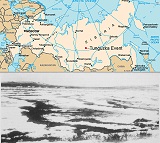Societal Influences
- See Full List of AI Topics -
 The
Tunguska event was a massive explosion that occurred on June 30, 1908, in the remote
Siberian region of Russia, near the Podkamennaya Tunguska River. It was one of the
largest recorded impact events in human history, and it led to increased interest
in the study of asteroids and comets. The event also served as a warning about the
potential dangers posed by objects from space and the need to track and monitor
them to avoid catastrophic impacts. The
Tunguska event was a massive explosion that occurred on June 30, 1908, in the remote
Siberian region of Russia, near the Podkamennaya Tunguska River. It was one of the
largest recorded impact events in human history, and it led to increased interest
in the study of asteroids and comets. The event also served as a warning about the
potential dangers posed by objects from space and the need to track and monitor
them to avoid catastrophic impacts.
The explosion was so powerful that it flattened an estimated 80 million trees,
which were knocked down in a radial pattern within 2,000 square kilometers around
the epicenter of the explosion. The trees in the center of the blast zone were stripped
of their branches and bark, and their trunks were scorched and charred.
One of the unusual features of the Tunguska event was the presence of broken
glass in the area surrounding the explosion. The glass, known as "Tektites," was
found in the soil and ice around the blast zone. Tektites are small, rounded, and
smooth glassy objects that can be formed when a meteorite or comet impacts the Earth's
surface. The Tektites found at the Tunguska event were unique in that they were
formed from the soil and sand in the area rather than from the impactor itself.
The exact cause of the Tunguska event is still a matter of scientific debate.
One popular theory is that it was caused by the explosion of a large meteoroid or
comet fragment in the Earth's atmosphere. The explosion is estimated to have had
a force of between 10 and 15 megatons of TNT, which is equivalent to the explosive
power of a large nuclear bomb.
The Tunguska event also had a long-lasting impact on the environment. The destruction
of so many trees caused significant changes to the local ecosystem, and it took
decades for the area to begin to recover. The explosion also generated a significant
amount of dust and debris, which was blown into the upper atmosphere and circulated
around the globe for years. This dust may have contributed to unusual atmospheric
phenomena and colorful sunsets seen around the world in the years following the
event.
This content was generated by the ChatGPT
artificial intelligence (AI) engine. Some review was performed to help detect and
correct any inaccuracies; however, you are encouraged to verify the information
yourself if it will be used for critical applications. In some cases, multiple solicitations
to ChatGPT were used to assimilate final content. Images and external hyperlinks
have also been added occasionally. Courts have ruled that AI-generated content is
not subject to copyright restrictions, but since I modify them, everything here
is protected by RF Cafe copyright. Your use of this data implies an agreement to
hold totally harmless Kirt Blattenberger, RF Cafe, and any and all of its assigns.
Thank you. Here are the major categories.
Electronics & High Tech
Companies | Electronics &
Tech Publications | Electronics &
Tech Pioneers | Electronics &
Tech Principles |
Tech Standards
Groups & Industry Associations |
Societal Influences on Technology
|




























